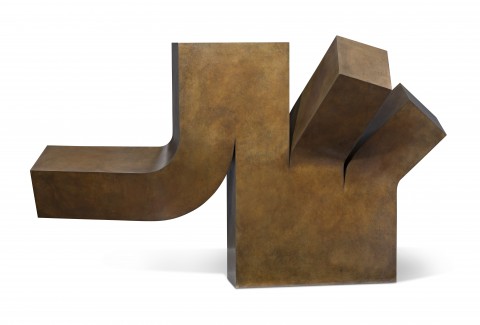WALLFLOWER, 1987
CLEMENT MEADMORE
bronze
57.0 x 97.0 x 46.0 cm
signed, dated and numbered at base: Meadmore 1987 1/6
stamped with Tallix foundry mark at base
Judith Meadmore, the artist’s wife, USA
Doyle, New York, 1 November 2016, lot 177
Private collection, Sydney
Deutscher and Hackett, Sydney, 10 May 2017, lot 60
Private collection, Sydney, acquired from the above
Gibson, E., The Sculpture of Clement Meadmore, Hudson Hills Press, New York, 1994, pp. 124 (illus.), 125
There is always a hidden power in Clement Meadmore’s sculptures.
An explanation is in order: if one drops a length of rope on the ground it always looks elegant – it’s in its nature that its curves are smooth and its lines supple. It is only when the human hand intervenes with knots, ties and stretching that internal complexity and underlying tension become involved – this the core of its power. A rope becomes more interesting when its nature is inverted – its natural pliancy is turned into a type of resistance.
The converse applies with steel when its inherent rigidity is made to bend. Clement Meadmore always knew this. He utilised the pointed significance of this odd analogy. In other words, in Meadmore’s sculptures the natural rigidity of steel is overturned to add internal complexity and underlying tension to an otherwise inert material – this is the core of its hidden power. Steel becomes more interesting when its nature is inverted – in Meadmore’s hands steel’s natural rigidity is turned into a type of pliancy.
Meadmore’s Wallflower, 1987 is a fine example of these highly individualistic hallmark attributes. The sculpture is the first of an edition of six and was originally in the collection of his former wife Judith Meadmore. Significantly, during the late 1980s, Meadmore created a small group of works in which ‘the wall’ was a common theme: Jericho, 1986; Wall for Bojangles, 1987; Wall king, 1988, and the present work on offer. Each appears to have begun with a solid rectangular form, the artist then proceeding to divide and shape portions of the block in his characteristic manner, slicing and shaping in a series of short gestures. Accordingly, such sculptures wrestle gently with gravity as the weight of the mass is contrasted against the lightness evoked by the curves. The titles specifically selected by Meadmore thus offer a direct insight into the artist’s thinking and the challenges he set himself with this group as he investigates how a delicate action, such as a curve or a cut, can alter the weight and feel of a larger, dominant form.
Notably, Meadmore’s Wallflower also bears that typical sense of arrested ‘movement’ that may be discerned in the best of the artist’s achievements. They always carry visual hints of animation as though steel – that most inert of materials – is somehow made to seem to curl, wiggle, flow and knot like wood shavings fallen from an imagined hand plane. Of course, the present work is not steel, but its bronze forms have a direct link to the monumental weathered Corten steel sculptures that made Meadmore internationally famous. It was a fame that was set on its path by the flowing elegance of his Awakening, 1968 in Melbourne’s Collins Street for the Australian Mutual Provident Society and is typified by his large majestically sited Virginia, 1970 (dedicated to the Australian artist Virginia Cuppaidge and situated in the Sculpture Garden of National Gallery of Australia), together with Curl, 1968 (Columbia University, New York). These large sculptures all sit happily in their spaces with a type of arms-folded insistence – not only that, they also seem to ‘make’ the space, like a good brooch ‘makes’ an outfit. Meadmore’s Wallflower possesses the same type of spatial poise.
KEN WACH
